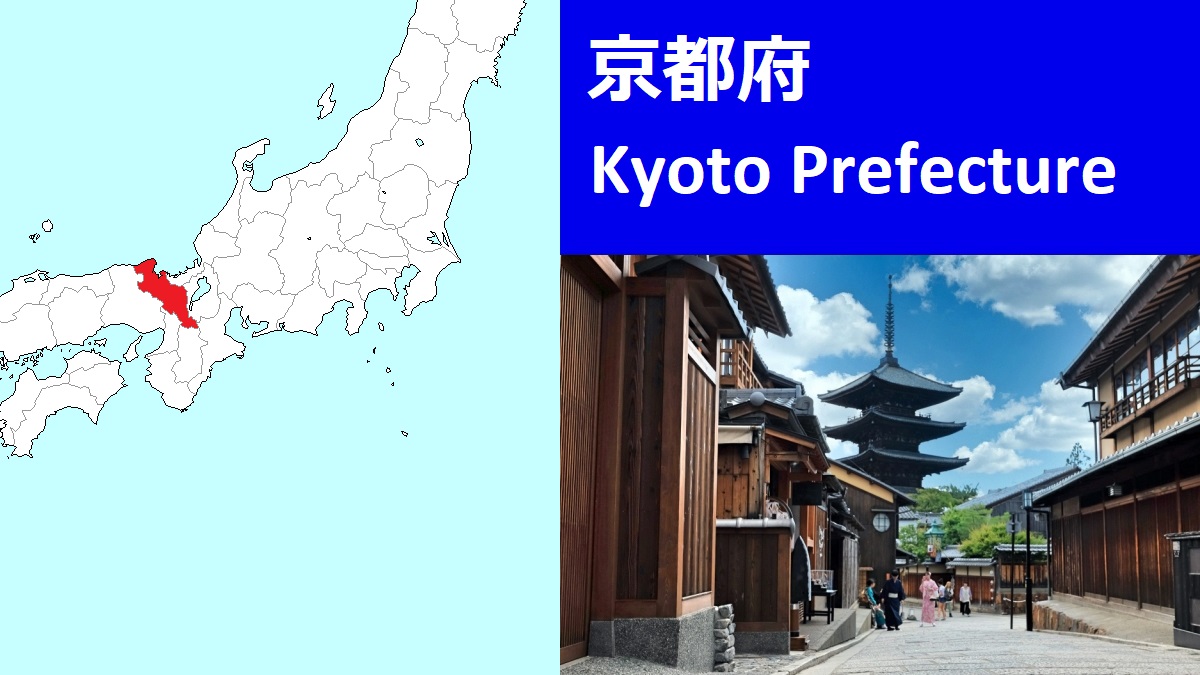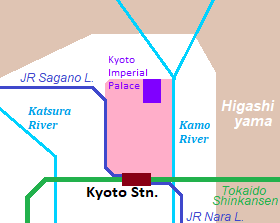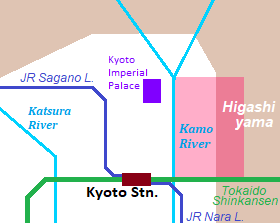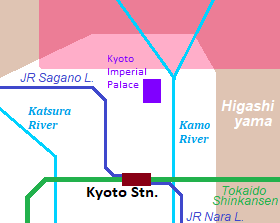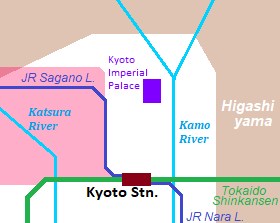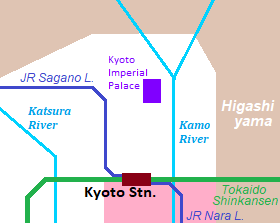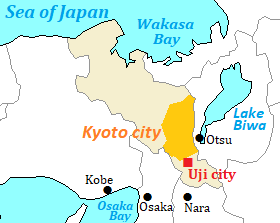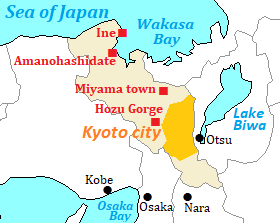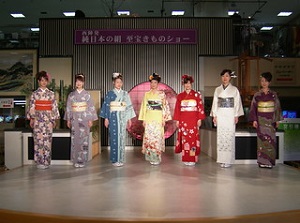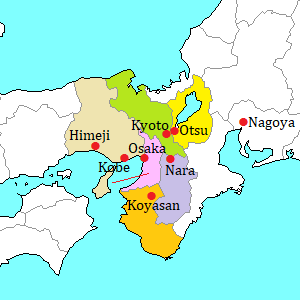Kyoto Prefecture [京都府]
Kyoto Prefecture is located to the north of Osaka.
The area is long from southeast to northwest, and the north area faces the sea of Japan and Wakasa Bay.
The whole area of the prefecture is hilly.
But it has no high mountain, and the altitude of the highest peak in the prefecture is under 1,000 meters.
In the south part of the prefecture, there are some historic cities such as Kyoto and Uji.
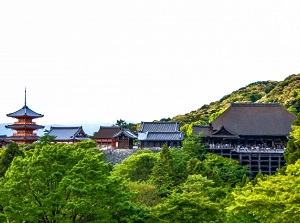
Kiyomizu-dera
Kyoto city (京都) is the prefectural capital in the southeast part of the prefecture.
It is the well-known historic city in Japan.
The population is about 1.5 million.
The first "o" in the word is pronounced long, so it is read as Kyôto
From the 5th to the 8th centuries, the capital of Japan was mainly around current Nara city.
In 794, Emperor Kanmu moved the capital to Kyoto.
Since that, Kyoto had been the capital of Japan for over 1,000 years until 1868.
During the period, this city had had Emperor, nobilities, samurais and ordinary citizens.
And they created various cultures.
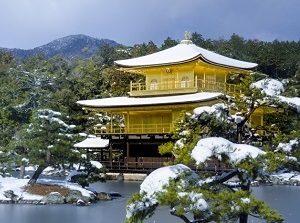
Kinkakuji in winter
The center of the city was modeled on Changan city which was the capital of Tang at that time. (Current Xian city in China)
The streets have been built on a grid.
The extent of main area is about 5.5 km from north to south (from Kyoto Imperial Palace to the south of Kyoto station) and about 4.5 km from east to west (from Higashiyama area to Kitano Tenmangu).
Many popular temples are dotted around the edge of this area.
Fortunately, Kyoto escaped the damage of World War II.
So, most historical buildings have kept the old townscapes in Kyoto.
17 constructions in the city are designated a World Heritage Site as Historic Monuments of Ancient Kyoto.
And there are about 20% of Japan's national treasures.
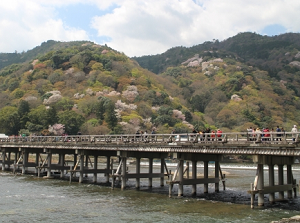
Arashiyama
Kamo River (鴨川) flows on the east side of the main area from north to south.
And, Katsura River (桂川) flows on the west side.
Kyoto city is in a basin surrounded by mountains on its three sides, the east, north, and west.
So, it is hot in summer and cold in winter.
But snow falls only in several days a year.
The gentle mountains on the east side of Kamo River are especially called Higashiyama (東山).
Along the foot of the mountain, there are many popular temples and spots.
The areas in the middle reach of Katsura River are Arashiyama (嵐山) and Saga (嵯峨).
These are at the western edge of the main area, and were originally an resort area for the nobilities.
Street name in central Kyoto
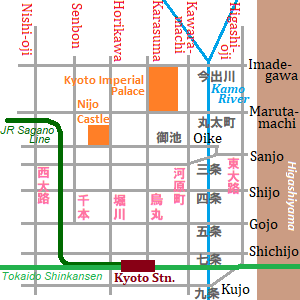
Current Kyoto has still the grid streets since the old time.
The main streets are in the map.
And each street has a name.
Roughly speaking, the northern edge of the ancient city is Imadegawa Street, the southern edge is Kujo Street, the eastern edge is Higashi-oji Street, and the western edge is Nishi-oji Street.
Kyoto Imperial Palace (Kyoto-Gosho, the Emperor's residence) was placed at the northernmost center position of the ancient city.
The streets from east to west and from north to south make a large town block.
And each block has the grids made by many narrow streets.
Basically, even the through narrow street has a name.
Most of the minimum blocks are about 120 to 150 meters from north to south and about 70 to 100 meters from east to west.
A few children's songs have been sung so that Kyoto people can memorize the names of the streets.
By the songs, about 30 streets from north to south and over 40 streets from east to west are known.
Thanksfully, most of the intersections in the Kyoto are named by the names of crossing two streets.
For example...
- Intersection of Shijo Street and Karasuma Street = Shijo-Karasuma
(Around Karasuma station of Hankyu Line) - Intersection of Oike Street and Horikawa Street = Horikawa-Oike
(At the southeast corner of Nijo Castle)
But there is no rule which street name is prior to the other.
If you has gotten lost in Kyoto city, go to a nearby main intersection first.
Check the name of the intersection, and you can probably find your position easily.
Caution to travel around Kyoto
Kyoto has been the biggest tourist city for Japanese people.
And recently, the number of tourists from abroad are increasing rapidly.
So, the whole area in Kyoto city is always overcrowded.
When you visit Kyoto, you must be prepared for the crowded places and transportation, shortage of accomodation, etc.
In addition, the people in Kyoto have complaints about the manner of foreign tourists.
They throw away the trash in the town, walk while eating, are noisy in the town and street, etc.
Especially, chasing and making fun of Maiko girls is hated.
Maiko is not the idol for tourist.
Their work is in the formal restaurant, so they basically ignore the tourist on the street.
The tourists should not call or touch to Maiko.
Kyoto is not a theme park.
It is the living place for citizen of Kyoto.
Please mind your manners.
Please, check the request of Kyoto city.
Transportation in Kyoto city
The sightseeing area in Kyoto city spreads within 5 to 10 km.
We can use route bus, subway and taxi.
Kyoto station of JR is the central statuon of railway, but the network of JR lines is poor in the main area of Kyoto city.
There are only a few stations of JR in the main area in Kyoto.
So, Japan Rail Pass can not be sufficiently utilized to travel around Kyoto.
And, the network of subway is not so enough, and only two lines are set up.
One is Karasuma Line running under Karasuma Street through Kyoto station.
Another is Tozai Line running under Oike Street.
So, main transportation is route bus.
But the route bus is very crowded in high season, and some buses sometimes overflow with passengers.
So I suggest you give yourself enough time to tour around Kyoto.
To tour around main spots, it is convenient to use a tour bus.
Tour buses with various tourist routes leave from Kyoto station.
If you want to visit by rental car, you should be prepare to get struck in a jam and stray into any narrow, one-way street.
Transportation
From Kansai Airport
By JR limited express, about 1 hour and 20 minutes.
From Tokyo, Nagoya
By Tokaido-Shinkansen, about 2 hours and 20 minutes from Tokyo, about 40 minutes from Nagoya.
From Osaka
- By Tokaido-Shinkansen from Shin-Osaka station, about 14 minutes.
- By rapid train of JR Kyoto Line, about 30 minutes from Osaka.
- By Keihan Railway, about 46 minutes by limited express from Kyobashi to Sanjo.
- By Hankyu Railway, about 44 minutes by limited express from Umeda to Kawaramachi.
Main events in Kyoto Prefecture
Aoi Festival (May 15)
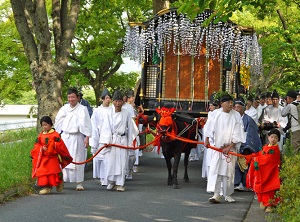
Photo by Kyoto Free Photo
Aoi Festival is the annual festival of Shimogamo Shrine and Kamigamo Shrine.
The festival had been held for nobility since the 9th century, but it had been lost in the samurai period.
In 1884, Emperor Meiji commanded to resume the festival, and it has been held every year since that.
About 500 people wearing the graceful costume of ancient nobility parade on the road in Kyoto city.
The route is from Gosho (Kyoto Imperial Palace) through Shimogamo Shrine to Kamigamo Shrine, and the distance is about 8 km.
"Aoi" means "hollyhock".
The people wear the leaves of hollyhock.
Gion Festival (July 1 to 31)
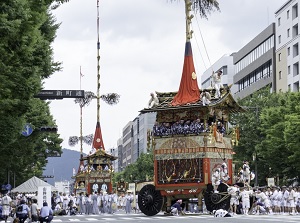
Gion Festival is the annual festival of Yasaka Shrine in Gion district.
It is one of the three major festival in Japan, along with Kanda festival in Tokyo and Tenjin Festival in Osaka.
And it is the famous festival with beautiful floats as well as Takayama Festival.
It is said that this festival has been held since 970.
As the festival of the shrine, various events are held for a month.
But the most popular events are Yoiyama in the evening from July 14 to 16, and the parade of floats is held on July 17.
In Yoiyama, the beautiful floats with lighted lanterns are set up at many town, and many stalls line there.
On July 17, 32 beautiful floats parade from Shijo-Karasuma through Shijo street, Kawaramachi street and Oike street.
This parade is called Yamahoko Junko.
Daimonji Okuribi (August 16)
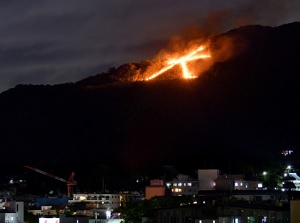
Daimonji Okuribi is the famous event in the Obon period.
The formal name is "Gozan Okuribi".
In the evening, five giant bonfires are lit on the mountains to the northwest, north and northeast of the city.
Each of them forms a kanji character or a sign.
Especially the character "Dai" is simple and clear, so it is the symbol of this event.
"Dai" means "big" or "large", and "monji" means "character".
In Obon, dead souls return to their families, and Kyoto people send the souls to the heaven at the last day of Obon.
This event is held in the day.
We can see the burning characters in the darkness.
Jidai Festival (October 22)
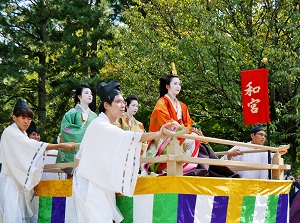
Photo by Kyoto Free Photo
Jidai Festival is the annual festival of Heian Shrine.
Heian Shrine was built in 1895, and this festival has been held every year since the first year.
"Jidai" means "era" or "period".
Eighteen groups of seven historical periods in Japan parade in the city.
About 2,000 people wearing the costume of each era parade.
The length of the procession is about 2 km.
The head of the procession is the group of Meiji Period (the late 19th century), and the following groups go back to the past in sequence.
The route is from Gosho (Kyoto Imperial Palace) through Marutamachi Street, Karasuma Street, Oike Street and Kawaramachi Street to Heian Shrine.
Local foods and products in Kyoto Prefecture
Kyoto Cuisine
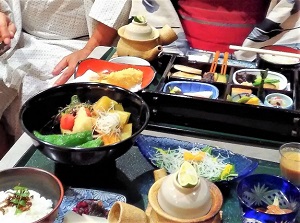
Kyoto Cuisine
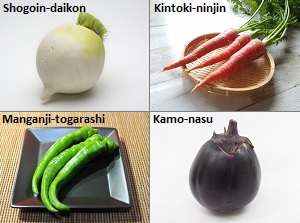
Kyoto vagetables
Kyoto Cuisine is a category of Japanese Cuisine.
Kyoto is inland, and the city is surrounded by mountains on three sides.
So, it had been difficult to get fresh fishes.
On the other hand, Kyoto had been the capital and there are many people of high status such as imperial family and noble families.
Therefore, the cooking using vegetables around Kyoto and soy products (tofu, yuba) had developed.
The cuisine is mixed with imperial cuisine, Buddhist cuisine, Kaiseki (cuisine from tea ceremony) and Obanzai (daily foods of Kyoto citizens).
The cooking uses the freshness of the ingredients and its natural taste, and the dishes are arranged beautifully.
And the taste is bland.
Most of vegetables are produced around Kyoto.
And some kinds of the vegetables has been only in Kyoto area.
They are a little unique in taste and shape in comparison with general vegetables produced across the country.
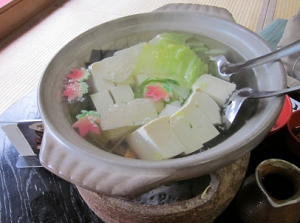
Yudofu
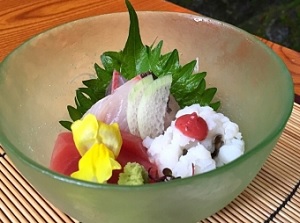
Boiled Hamo & Sashimi
The dishes using tofu and yuba are popular as Kyoto cuisine.
Tofu in Kyoto is made with soft groundwater, so it is mild and tasty.
Yuba is a skin produced on the surface of boiled soy milk.
(Along with Kyoto, yuba in Nikko is famous.)
As a popular dish in Kyoto, "Yudofu" (simply boiled tofu) is well-known.
In former days, it was difficult to get various fishes in Kyoto.
But, "hamo" (pike eel) has been a valuable fish in summer.
The fish is like eel with sharp teeth.
And the life force is strong, so hamo had been carried alive from sea to Kyoto.
The taste is bland.
Hamo dishes are most popular cuisine in summer.
Pickles of Kyoto
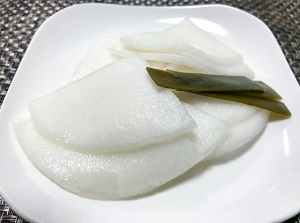
Senmai-zuke
Kyoto has a culture that some pickles are served at meals.
Various pickles are produced and are selled as one of daily foods and souvenirs.
It is said that the three major pickles in Kyoto are Shiba-zuke, Suguki and Senmai-zuke.
Shiba-zuke is made by salting chopped eggplants with red perilla for about a year.
Suguki is a kind of turnip, and is made by fermenting it in a cask for a year.
It has a unique sour taste.
Senmai-zuke is made by pickling thin-sliced turnip with konbu (seaweed) and hot pepper in vinegar.
Yatsuhashi
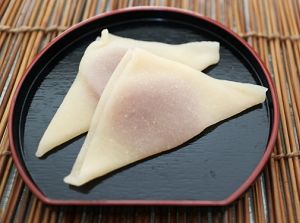
Unbaked Yatsuhashi
Yatsuhashi is a confectionary made in Kyoto.
It is made from rice flour, sugar and cinnamon.
Baked Yatsuhashi is similar to senbei (Japanese cracker or cookie).
Unbaked Yatsuhashi has a soft and mochi-like texture, and is often eaten wrapped around "an" (sweet red bean jam).
In the 17th century, Yatsuhashi Kengyo Yatsuhashi, who was a leading Japanese harp musician, gave the idea of this confectionary to his acquaintance of tea house.
The acquaintance made a confectionery baked into the shape of Japanese harp, and he gave this the name of "Yatsuhashi".
Kyoto Yuzen Dying
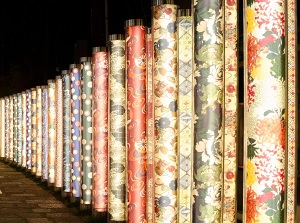
Displaying art of Kyoto Yuzen
Yuzen Dying is the famous dying in Japan, and was invented by Miyazaki Yuzensai living in Kyoto in the 1690s.
He was a popular painter of folding fan, and he created the method to draw a picture on silk fabric and to color with dyes.
This method had made Kimono very beautiful and gorgeous.
To complete a work, there are many processes.
And many craftmen get involved the works.
By the way, Yuzensai moved to Kanazawa in his later years, and spread Yuzen dying in the area.
It is the excellent Kaga Yuzen Dying.
Nishijin Textiles
Nishijin is the area to the northwest of Kyoto city.
Since the 16th century, many excellent craftmen had gathered in this area and silk textile industry had developed.
And, in the 1870s, mechanical looms were introduced from France, and various Nishijin works enabled the mass production.
Nishijin is still the Japan's leading traditional textile.
Gorgeous Kimono is mainly by Yuzen Dying, but obi (Kimono belt) and various wears are mainly by Nishijin textile.

